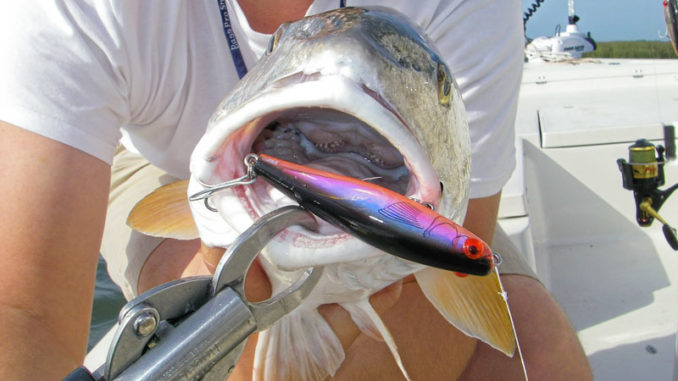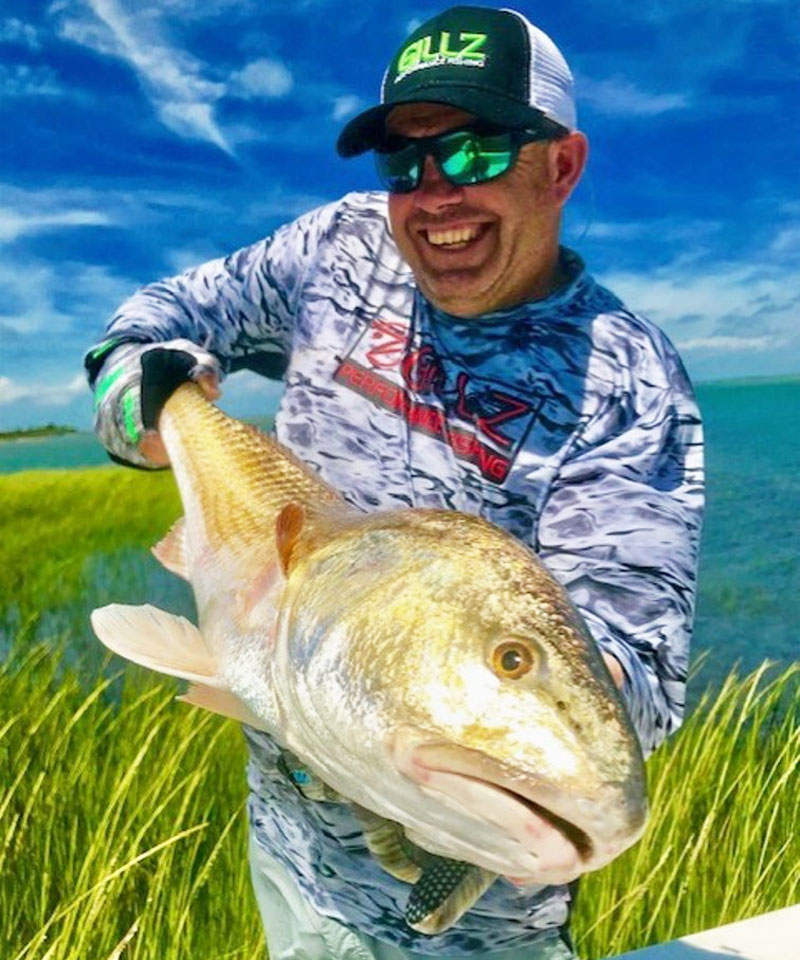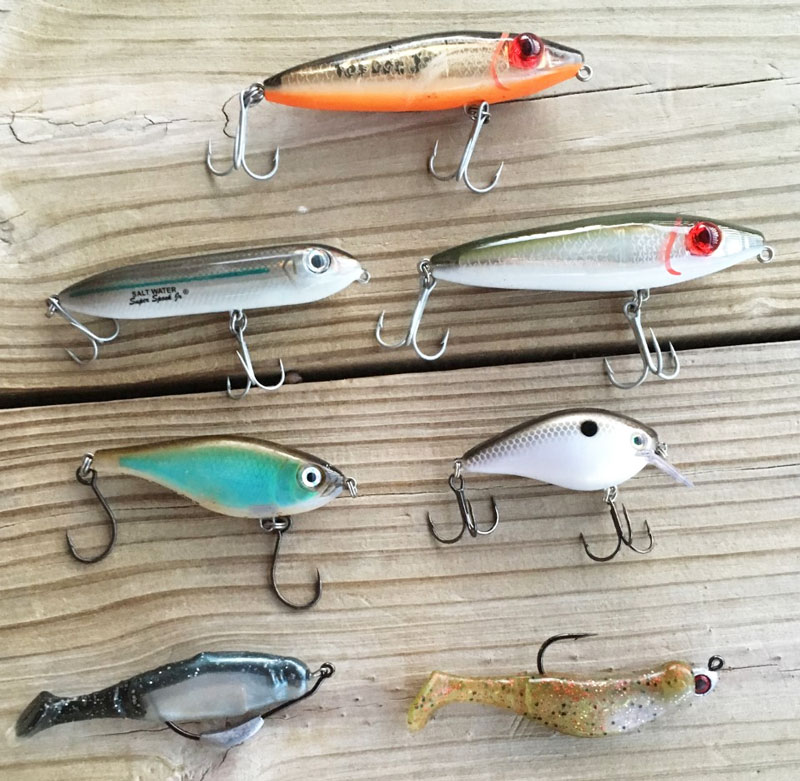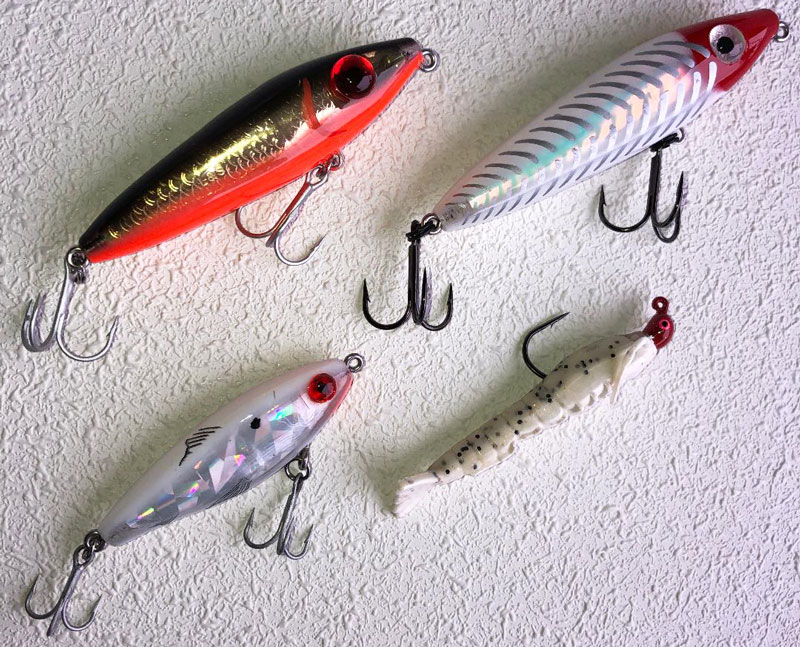
Three North Carolina fishing guides fit their lure offerings to changing conditions when transition reds are the target
Truth be told, fishing for red drum during May and June isn’t easy.
Veteran anglers call these months “the transition” time, because huge schools of redfish are moving from the ocean to inshore waters, following spawning menhaden into North Carolina’s sounds, marsh creeks, rivers and bays.
Once behind the barrier islands, schools fracture into smaller pods spread across millions of watery acres where they find saltwater habitats teeming with multiple food sources. Warming marsh waters bloom with oyster reefs infested by tiny black crabs, while bays, creeks and rivers contain other crab species, mud minnows and juvenile fish. Shrimp and finger mullets soon join the migration.
What’s a hungry red to do other than partake of this shallow-water smorgasbord?
A key for anglers is finding the food sources, but the hottest bites vary depending on water clarity and temperature, depth, tides and wind direction, factors known to serious local anglers and guides.
Those components also affect the artificial lures used. Which ones should an angler choose? Three guides who chase reds from Harkers Island to Carolina Beach shared their ideas.
Topwater
Guide Noah Lynk of Harkers Island fishes the waters around Cape Lookout every chance he gets.
“Topwater fishing for drum is best at low tides in shallow water,” said Lynk, 49, of Noah’s Ark Fishing Charters (252-342-6911). “Red drum are mainly bottom-feeders with a low-slung mouth, so they have to get above a topwater lure.”

He uses all the MirrOlure walking surface baits, including Top Dog Jrs. and Top Pups, small lures that resemble small menhaden.
“Lure color doesn’t matter as long as it’s got a white belly,” said Lynk, who also takes sound into consideration, because MirrOlures have rattles with different sound pitches: high, medium or low.
“If (redfish) don’t react to one, I’ll try another until I find one they like,” he said.
The best topwater strike zones for redfish are in 1 to 2 feet of water near marsh-grass edges and oyster-rock points.
“Reds grub in protected grasses for crabs, little shrimp and small minnows,” he said. “I like oyster rocks near grass, but sometimes I find them on shoals in the middle of a bay.”
He looks for the backs of fish, “or you might see swirls, beat-up water.”
Lynk said the key to hooking a red drum with a topwater lure is to not try to set the hook as soon as a fish strikes.
“You get a lot of blow-ups, so don’t snatch a lure,” Lynk said. “Wait ’til you feel his weight, then set the hook.”
Guide David Towler of Towler Time Charters has fished the waters around Swansboro for years. He likes to cast a 4-inch Top Dog Jr. or She Dog Jr. for surface-feeding reds, plus a MirrOlure 808 (orange belly/gold sides/black back) .
“The bulk of the baitfish in late May and early June will be little menhaden), so I use smaller lures,” said Towler (910-554-4742). “I like flats and 2- to 5-foot (deep) channels around oyster rocks and marsh edges.”

Towler makes parallel casts to marsh banks or across oyster rocks.
“You can fish topwater lures all day in June, especially when (menhaden) are plentiful inside,” he said. “A 3¾-inch Zara Spook Jr. with a white belly and silver sides is a great lure because it looks like a crippled minnow and sits up a little higher in the water.”
Towler said the red drum bite in inshore waters around his base in the town of Hubert begins when the surface water temperature reaches 64 or 65 degrees.
Farther south, Jot Owens of Wilmington’s Jot It Down Guide Service, hunts redfish from Figure Eight Island to Carolina Beach. His favorite surface lures are 4-inch Top Dog Jrs. and Top Pups with a red head and white body or a MirrOlure 808.
“I only use a 3½-inch Top Pup when it’s really calm,” said Owens (910-233-4139), who fishes topwaters in depths of 8 inches to 2½ feet.
“Best places are shallow flats, marsh and creek edges,” Owens said. “I like oyster rocks near grass.”
Topwater fishing is best during early morning or late-evening hours, he said. “Low -light conditions are best; cloudy or foggy days are a bonus.”
Soft plastics near the bottom
Owens prefers a 3- or 4-inch Gulp shrimp impregnated with shrimp or menhaden scent.
“If I’m throwing it on deeper structure, 5 to 15 feet deep, I’ll use a ¼- or 3/8-ounce jighead,” he said, “but I like some tidal current. I’ll throw these lures in shallow water on higher tides and in deeper holes on lower tides. Good places are (Intracoastal Waterway) docks and holes the first two hours of a falling tide and the first two hours of a rising tide.”
Owens said he doesn’t “get crazy” about lure colors, but sugar-spice glow — a natural pearl color with pepper metal flakes — is a favorite.
Lynk switches to soft plastics when the topwater bite dies out.
“Many Flukes and paddletails will catch reds, but my favorite is a Fishbites Fight Club shrimp,” he said. “They’re scented with shrimp and (menhaden) and come in jerkbaits, paddletails and curlytails.”
He prefers 1/8- to ¼-ounce jigheads because they sink slowly.

“You’re likely to get bit by (spotted) seatrout, too,” Lynk said. “I like a short leader to work these lures 1 to 2 inches off the bottom and above oyster shells.”
Towler’s preferred soft-plastic lure is the Z-Man Scented PogyZ, a 3- or 3¼-inch lure that “looks exactly like a little pogey, which are everywhere.”
“I fish with them in the exact same places as I do my topwater lures, which means where I see pogeys,” he said. “I throw them parallel to marsh shores and around oyster rocks.”
He threads weighted worm hooks on teardrop-shaped PogyZs, which have paddle tails, fat bellies and gray backs and mimic small menhaden.
Another effective mid-range, soft-plastic paddletail is a black back/silver flake Z-Man DieZel MinnowZ Mulletron.
Sub-surface baits
Lynk’s favorite sub-surface lure is the 4-inch Halco C-Gar, a combination mid-depth, walk-the-dog lure.
“It sinks quickly, but you can pop it to the top quickly,” he said.
A C-Gar’s weight makes it ideal for long casts to single fish or fish-pod edges.
“If the wind’s right you can throw it 40 yards,” Lynk said. “I might try it at the Cape Lookout Coast Guard station, the rock jetty at Fort Macon, the Cape Lookout jetty, the Haystacks (Newport River marshes), North River or east banks of Cape Lookout. Reds also hang around aquaculture farmers’ floating (oyster) bags.”
Lynk also throws a 17 MirrOlure, a suspending lure.
Towler’s most-effective mid-depth lure is a favorite of largemouth anglers, a Mann’s Baby 1-Minus crankbait.
“It’s a fat, short-lipped lure,” he said. “You can slow-roll it, and it wobbles. Reds also will tear up a bronze Cordell stickbait. I try to keep those lures in the 3- to 4-foot (depth) range.”
His favorite colors include pogey (white-gray-green) and Houdini (red/white with red glitter).
Owens likes a MirrOLure 17MR that runs a foot or two deep.
With clear water and a bright sky, reds move from flats to marsh creek channels with water in 5- to 6-foot depths.
“You can find that depth just off the marsh creek edges, so I’ll throw the 17 MR parallel to the banks,” Owens said. “I also catch a lot of sea trout with that lure.”


